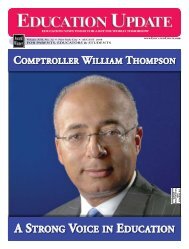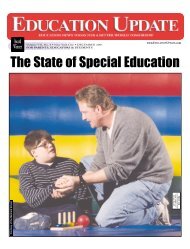Education Update - July 2002
Education Update - July 2002
Education Update - July 2002
Create successful ePaper yourself
Turn your PDF publications into a flip-book with our unique Google optimized e-Paper software.
JULY <strong>2002</strong> ■ EDUCATION UPDATE ■ SPOTLIGHT ON SCHOOLSSCHOOL9Paige Discusses After-School ProgramsBy TOM KERTES(Exclusive to <strong>Education</strong> <strong>Update</strong>)President George W. Bush’s “No Child LeftBehind” initiative has a quartet of major components:accountability for results; flexibilityand local control; expanded parental optionsand doing what works in the classroom. “Andthese points apply equally to after-school andsummer programs, whether they’re provided inor out of the classroom,” Secretary of<strong>Education</strong> Rod Paige said recently at a SatelliteTown Meeting.According to Secretary Paige, after-schooland summer programs are extremely important.“The parents of more than 28 million schoolage children work outside the home and asmany as 15 million “latch-key” children returnto an empty house on any given afternoon,” hesaid. “All studies have shown that after theschoolbell rings, too many children withoutadequate supervision may neglect necessaryschool-work or, worse, fall prey to negativeinfluences. In fact, children are at a greater riskof being involved in crime, substance abuse,and teenage pregnancy in the hours afterschool– peaking between 3-4 p.m.”“Yet, since, in spite of all this, after-schoolprograms are so inadequately funded, creatinglocal partnerships with corporations, faithbasedorganizations, and the community isextremely important,” said Michael LeFlore,the Director of IMPACT Afterschool Programin Phoenix, Arizona. “Our success in doing thathas allowed us to keep our programs in linewith state standards and provide a diverse outlookon education that has led to higher gradesand greater parent participation.”Variety in quality programming is also of theessence. “In the INTEL Computer Clubhouse,we really try to keep a club atmosphere – itseems to inspire children,” said RomaAvellano, <strong>Education</strong> Manager on INTELCorporation. “The computers are organized inclusters, they are not facing the wall. The studentslearn skills that people use as professionals– so we use the very highest technologyavailable in our music studio and video editingcenters. And the students’ creativity is furtherencouraged and enhanced by the presence ofadult and older student mentors.”“We did this because we felt that society hasdeveloped a technology gap between childrenof different backgrounds,” Avellano added.“And we could not allow this technology gapbecome first a skills gap, and then an achievementgap.”Carla Sanger, Executive Director of LA’SBEST, one of the nation’s most outstandingafterschool programs, spoke of accountabilityand results. “We must work within articulatedhigh standards,” she said. “We have 17,500kids coming to work with us each and everyday. And the outcome measures are sometimessurprising: among others, one that made us feelgood was that children have reported greaterconfidence in going to adults in problem-solvingsituations after working with us.”LA’S BEST has also shown positive resultsin reading ability, increase of self-esteem, andpride in learning. According to one of the highschool mentors “this is great; when I have childrenI’ll be able to teach them myself about awhole variety of different things.”All participants agreed that the No. 1 key to aquality afterschool or summer program isinvolvement in the school, talking to teachers,talking to parents, talking to kids. “We have tofind out what’s real to the children, we must haveadult mentors who really, really listen,” Sangersaid.#HOW THE CONSTITUTIONWORKS FOR STUDENTSBy ARI MCKENNAIn a sparsely furnished courtroom inManhattan recently, students from IS 89 hadthe opportunity to mock-try a Supreme CourtCase on National Security vs. The FirstAmendment. Equipped with suits, some robes,a large wooden hammer and some soundknowledge of the Constitution, the studentsplayed out the case, which lingers in the shadowof the September 11 th attack on the WorldTrade Center and explores democracy.IS 89 is only one of approximately 400schools in the New York area that take part insuch activities, due to their collaboration withthe Constitution Works (TCW) program. Nowin its fourteenth year TCW is a veritable harbingerof conscious and active future citizenswho will participate in government.Here is how The Constitution Works works:The Board of <strong>Education</strong> offers a supplementaryprogram, which satisfies requirements in socialstudies and language arts to teachers of civics,social studies, and related subjects. TCW,whose full-time staff includes Thomas Stokes(Executive Director), Rosa Taveras (ProgramManager), and Eric Neutoch (ProgramAssociate), holds training workshops for thoseteachers, brushing them up on their constitutionalknowledge, introducing them to methodologiesconcerning group work, interdependence,and active student participation, andeventually putting them through a role-playedcourt case.Before they return to the classroom they aregiven a “unit” to introduce to their respectiveclasses. While some units may be moreinvolved with the Executive or Legislativebranches, most deal with the Judicial branchand are usually recent Supreme Court caseswith current implications.Students start with groundwork introductionon relevant excerpts from the Constitution andthe Bill of Rights. As the process continuesthey receive roles and engage specifically withtheir own “unit.” Upon the teacher’s request,TCW provides technical support in the form oflaw students from Fordham University, volunteerattorneys, and TCW staffers who are ableto help kids on a more one-on-one basis.TCW is involved with public, private,Jewish, and Catholic schools as well as someadult education centers. It is privately fundedbut has recently been seeking public fundingwith the help of Borough President VirginaiFields.While working with a bilingual class thatTCW services, Taveras noticed an interestingphenomenon: many of the South American studentsrefused to take the side which was inopposition to the government because theywere “afraid of punishment.” At this point,Taveras explained the first amendment’s secondclause, involving free speech and freepress. Taveras notes that the American studentshad no such qualms about opposing the state;“they don’t see it as going against the government,they see it as ‘this is my right.”The Constitution Works has reached about100,000 students, establishing and sending outinto the future a “Reserve of Uprights” of sorts,emerging young citizens aware of their ownpersonal-political contexts who will participatein government with acuity, awareness andknowledge.#Skills for school. Confidence for everything else.For more than 20 years, Sylvan has helped over a million childrendevelop a love of learning. We get results through a proven process thatworks — the Sylvan Advantage ṬM• We begin by identifying each child’s specific needs, then we provideindividual attention and personalized lesson plans.• Sylvan teachers are highly trained and certified — and just loveteaching.• We keep you updated every step of the way with regularly scheduledconferences and progress reports.If your child is struggling in school or just isn’t being challengedenough, call Sylvan today.www.educate.comNow with 6 convenient locations in New York CityCall us today at 1-800-EDUCATEREADING MATH WRITING STUDY SKILLS SAT ® /ACT PREP
















